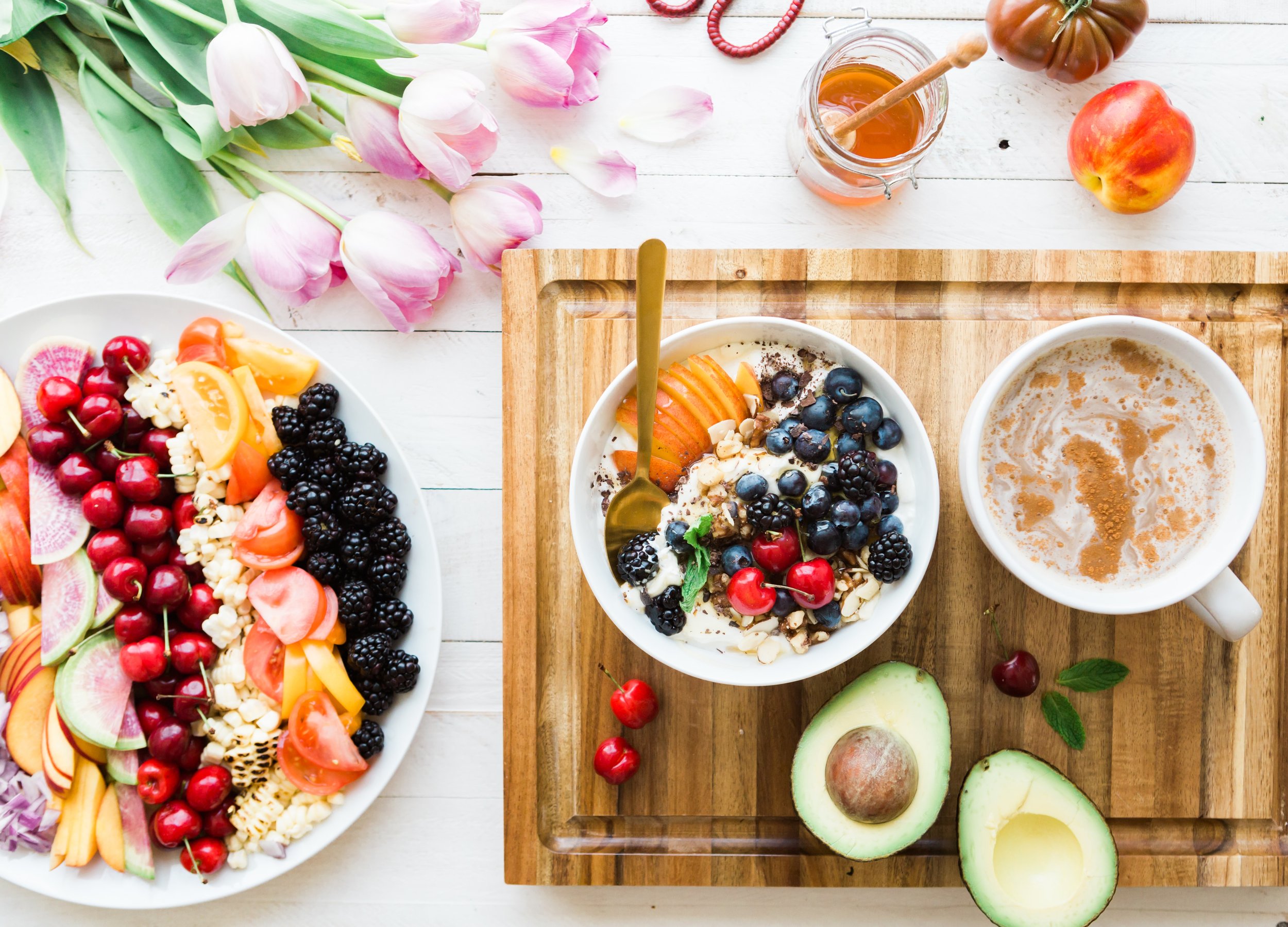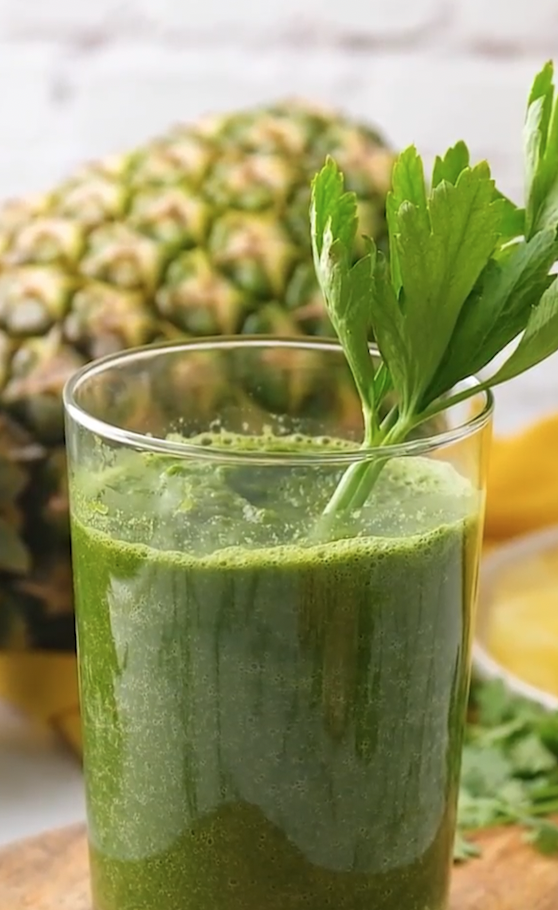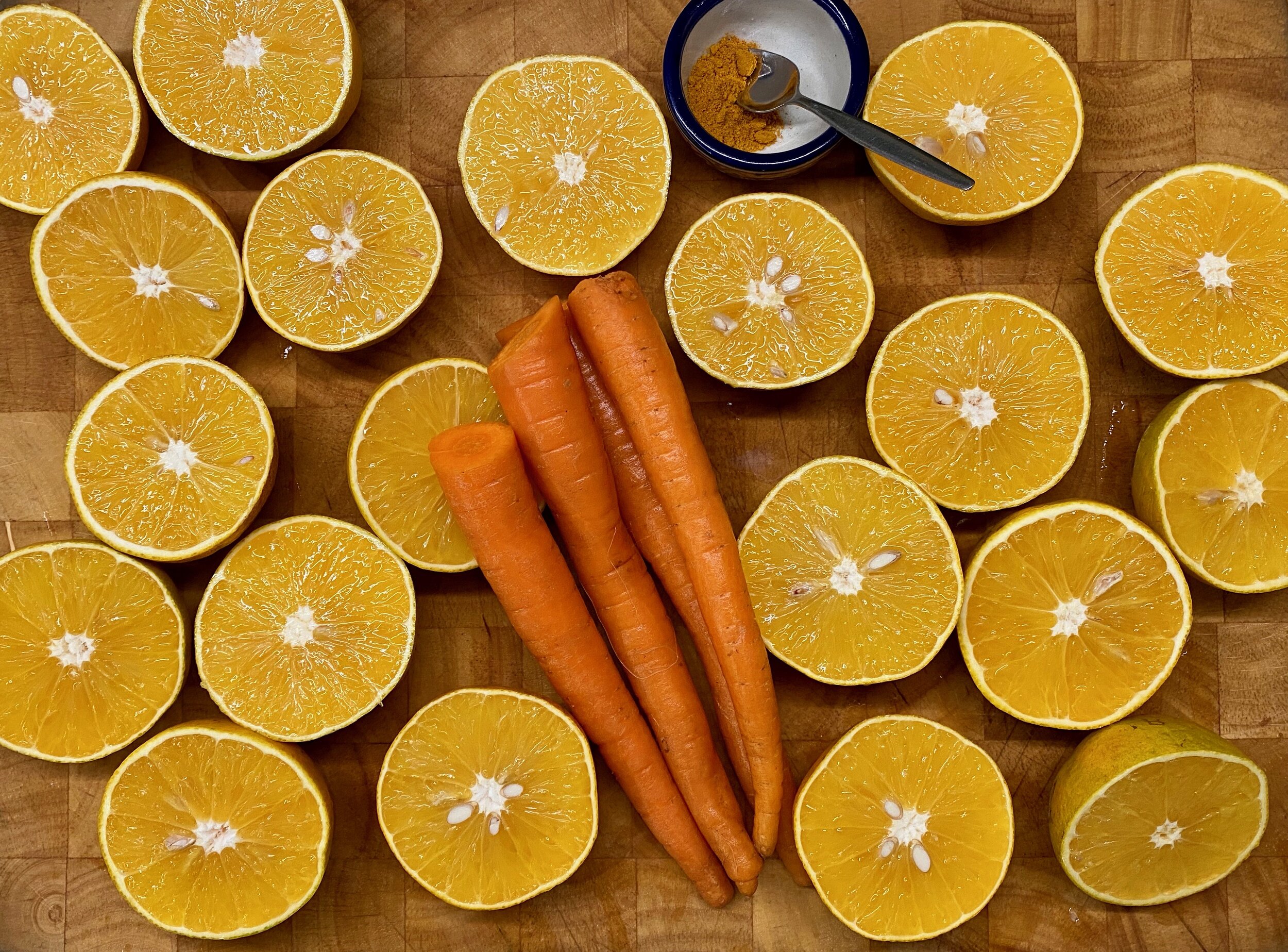
FOOD MEDICINE
real food recipes with a food as medicine philosophy.
Four Season Roasted Cauliflower Salad
A roasted cauliflower salad with a punch of lemon and the comfort of a smooth tahini dressing.
Roasted Cauliflower Salad
4 sides or 2 entrees
Inspired by an Ottolenghi recipe.
I love roasting cauliflower and tossing with a simple garlicky tahini, add toasted walnuts and sweet cherry tomatoes and you have a dreamy satisfying meal. But honestly, any toasted nut and sweet fruit like pomegranate seeds, golden raisins or dried apricots will do.
Cauliflower comes from the Brassica family. It is high in fiber, vitamin C and well known for its anti-inflammatory benefits. Its low carb status also make it a great choice to add to your weight loss and heart health dietary plan. Nutritious or nut, there is a comfort that comes when you dive into a perfectly roasted bowl of cauliflower, minus the brain fog that most comfort food offers.
This is a year round vegetable for me and does well shaved into salads, roasted in the oven and even made into cauliflower steaks on the grill. Anyway you slice it, cauliflower is going to do your body good.
INGREDIENTS
1 head of cauliflower
1 small onion, sliced
2-3 tablespoons olive oil
1 cup mixed chopped herbs, (mint, parsley, basil, cilantro, whatever you have on hand)
1/2 lemon, grated peel and juice
1/2 cup toasted walnut pieces
2 tablespoons tahini
2 garlic cloves
Pinch of salt, pepper, cumin
PREPARE
Preheat oven to 425 F
Coarsely grate 2-3 large florets with a box grater and set aside.
Break the remaining cauliflower into bite size pieces. Don’t discard the leaves and stems, slice these and add them to the florets. Roughly slice a small onion. Toss florets, leaves, stems and onions together with 2 tablespoons of olive oil, salt, pepper and cumin. Spread mixture onto a parchment paper lined baking sheet and roast until golden brown, about 20-25 minutes. Set aside to cool.
Once cooled, add herbs, 1 tablespoon lemon juice and grated peel. Toss together. Drizzle with tahini sauce and top with roasted walnuts, cherry tomatoes and raw shaved cauliflower. Serve with pita.
TAHINI SAUCE
In a food processor add 2 tablespoons tahini, 1-2 garlic cloves, remaining lemon juice (about 1 tablespoon) and blend until smooth. If a thick paste forms, slowly add warm water (up to 1/4 cup) to thin the sauce to your desired consistency. Leftover sauce can be added to salads and used as a veggie dip. Will hold for 1 week in the fridge.
MY TINY GRATITUDE
A Tiny Gratitude from my mom’s recipe box.
Around Thanksgiving The NY Times had a call for 100 words or less “tiny gratitude” stories. In a few minutes time I had an idea, it would be an homage to my parents. I began writing about my mom’s recipe box and my dad’s stuffing patties, but alas, 100 words goes fast. I was thinking of my dad sitting with his yellow legal pad, responding to an op/ed piece in his local paper. He had a lot to say and was published often.
My 100 words or less Tiny Gratitude went through many renditions and ended up coming down to talking about one recipe, by far the most popular recipe in our family. It’s a family favorite any time of year. And although my writing did not get chosen for The NY Times, I enjoyed the process and feel such gratitude for going through it!
My Tiny Gratitude 2022
I don't have many keepsakes from my parents but what I am most grateful for is my mom’s busting at the seams recipe box, filled with those hand written goodies of my youth. The worn out folds and butter stained edges of the Chocolate Chip Loaf recipe clearly tells a tale about popularity. I could never figure out how to make the meringue topping as fluffy as mom’s, but over the years, my siblings and I have each found our way to the perfect "loaf", and as I read the list of ingredients written in my mom's handwriting, the true gift is knowing this recipe binds our family together.
GOOD MOOD FOOD
Good Mood Food: Increased intake of fresh fruit and vegetables enhances mental health.
DID YOU KNOW?
People who eat more fruit and vegetables score higher on every facet of mental health evaluations. Scientists aren’t quite sure the reasoning, but what has come to light is that many people with depression often have lower blood levels of folate, vitamin C and potassium - three vitamins that are found in high amounts in fresh fruit and vegetables. In a 2016 New Zealand study the data showed that eating more fresh fruit and vegetables enhanced positive mental health scores. Read the study HERE.
Feed Your Microbiome Good Carbs
A Varied Diet = A Happy Gut = A Happy Brain
In general, when you eat a varied diet of different types of fruits and vegetables, your microbiome becomes more diverse and quite simply, more joyful. A more diverse microbiome can translate to more balanced emotions, hormones, digestive energy, which all have an effect on mood. The challenge I pose myself, my clients and my cleansers alike is to ingest 30 different plants each day. Over time you will have grown a happy gut, a happy complexion, a happy mindset, and a happy body. Here is a list of some of the important types of starches that the microbiome thrives from.
Inulin - artichokes, garlic, onions, asparagus, chicory, dandelion greens
Fructooligosaccharides - banana, onion, garlic, asparagus
Resistant Starch - legumes, green bananas, oats, barley, sorghum, rice
Pectin - apples, apricot, carrots, oranges
Arabinoxylan - grains
Arabinogalactan - carrots, pears, corn, tomatoes, turmeric
Don’t Worry, Be Happy
The Earth Element, aka Stomach and Spleen, thrive on mindful eating and suffer when there are prolonged periods of worry.
In Chinese medicine, it is the Earth element that governs the complexity between mindset and digestive health. One way to improve common digestive complaints that relate to a weak microbiome or perhaps a stressed out digestive tract is to add in mindful eating strategies to that list of happy gut carbs. It took me a few meditation retreats to make the connection between my chronic gas and bloating and mindful awareness of how I was eating, along with when I was eating. Three square meals per day, eaten with intention over 5 days was the Ahh-ha moment for me. See some strategies below that I have found to be helpful in regulating many of my longterm digestive issues. In my Eastern Nutrition classes we learned the following:
Eat until you are 2/3’s full
Eat with intention, meaning, solely focus on eating when you sit down for a meal
Eat at regular times/intervals, the stomach likes regularity
Eat slowly. Put your fork down between bites and spend time chewing your food, noticing the flavors, textures, etc
There is no one size fits all method to finding the right mental wellness path for everyone. If you are suffering from anxiety and depression, please speak with a professional, and consider including food medicine as one of the many approaches to your mental wellness journey. Need help connecting with someone? Please reach out.
ANYTIME MISO
Miso is a wonderful addition to a cleanse, but it also has it’s place at any meal, served ofer noodles, porridge, vegetables or simply plain. It takes no time to prepare making it a winner in my weekly menu planning.
Miso is a traditional Japanese soup that I have come to love for many reasons. It is a great source of vitamins, minerals and probiotics, all important for the health of your gut. The fermentation process of the soybeans is not only good for your gut, but over time enhances your ability to digest more efficiently the nutrients that you ingest from the soup. Isoflavones are a big one here, found in soy beans and known to enhance heart health and ease menopause symptoms.
Miso soup can be eaten as a simple savory morning soup, poured over porridge and vegetables or simply eaten on its own as a snack or a meal.
INGREDIENTS:
3 cups vegetable stock
1 inch nob of ginger
1-2 tablespoons miso
1-2 kale leaves thinly sliced
4-5 shitakes, thinly sliced
1-2 scallions, thinly sliced
In a medium sauce an, add 3 cups of vegetable stock with ginger and bring to a boil, let simmer for 10 minutes. At 9 minutes, add in the kale, shiitakes and any other veggies and cover. Ready to eat when kale has softened. Top with sliced scallions. Season with dulce, tamari, sriracha, lime/
Some favorite add ons include buckwheat noodles, sesame oil, soft boiled egg, kimchi.
Enjoy!
PINA VERDE GREEN DRINK
Pineapple, spinach and cilantro green drink.
Pineapple, spinach and cilantro pack this green drink full of flavor and health benefits. I am a smoothie goddess in the heat of summer and this one always sets me straight. This recipe can be juiced or blended. I like the blended version because you get all the beneficial fiber. Want something lighter? Run all the ingredients through the juicer. The end result is a deliciously bright, healthy green drink that will have your skin glowing, mind sharp and energy vibrant.
INGREDIENTS
1 inch slice of whole pineapple
1 handful of cilantro
1 handful of spinach
1/2 large cucumber, slices
1 celery stalk
3 romaine leaves
1 inch piece of ginger
DIRECTIONS
Blend all ingredients until smooth or run through a juicer.
The Goddess of Green Goddesses
Simple. Versatile. Green Goddess.
A happy accident was how this green goddess sauce began. And now it has become a regular with many variations using whatever herbs and veggies I have on hand. But it started with a search on the internet for the best green goddess dressing and ended with my amped up version and now many variations since then. I no longer stick to a recipe because no matter how you slice it, herbs and mayo or yogurt or avocado ALWAYS go together well.
My Green Goddess v1 is still the best according to my daughter and her friends, so here it goes.
INGREDIENTS
1 cup each basil, cilantro
1/2 cup chives
2 scallion stalks, trimmed ends
1 cup veganaise
1/2 cup oat milk (I like Oatley 2%)
1 tablespoon lemon juice
1 tablespoon lime juice
2 cloves garlic
1 teaspoon olive tampenade or capers
Salt and pepper to taste
PREPARATION
Start by making the vegan buttermilk. Whisk the lemon juice with the oat milk, set aside.
In a blender or food processor, add all the other ingredients and blend well, slowly drizzle in oat milk until you have the perfect consistency for your sauce. I like it thicker to use as a dip and thinner to use as a dressing so you may or may not need all the “buttermilk”. Enjoy!
MY FAVORITE ORANGE JUICE RECIPE - 3 Ingredients
3-Ingredient anti-inflammatory orange juice.
As we have all most likely experienced, grocery shopping is getting stressful. My last visit to my local store had me in and out quickly only sticking to the open air fruit and vegetable area. I saw a bag of juicing oranges and thought it would be a great treat to make my family some fresh squeezed orange juice one morning.
After 3 weeks of social distancing and staying at home, I have gotten into somewhat of a healthy routine cooking, yoga, meditation and exercise, but it does feel like someone is constantly cleaning dishes. Between prepping vegetables, baking sweets, trying new recipes I never had the time for, and then making time for keeping up with work related issues, it seems like the day flies by. What I have found for myself is that if I start the day out healthy, I tend to finish it more healthy, and even if I do give in to some comfort food and a glass or two of wine, I know I have crowded out most of the foods that don’t do my body good.
This recipe does require a juicer and is a bit messy, but your family will appreciate every sip because it is that delicious. I am a huge believer in eating real food to get necessary vitamins and minerals, I take supplements too, but in times like these it is even more important to eat well because our microbiome needs to be fed a wide variety of fruits and vegetables to remain diverse and healthy. A diverse microbiome has been linked to longer life and a significantly lower incidence of chronic and acute illness. Feeding your gut biome a variety of fresh food and fermented vegetables (link to my sauerkraut recipe here) can be some of the best healing you can offer yourself and your family during the Coronavirus pandemic. Stay safe, eat well and stay home.
INGREDIENTS
10 juicing oranges
4 large carrots
3/4 teaspoon powdered turmeric
PREPARATION
Wash carrots, leave skins in tact. Cut oranges in half and cut away the skins. Juice everything and whisk in the turmeric. You can also use fresh turmeric and grate it into the juice directly, about 1/2 teaspoon per cup will do.
Congee: Convalescing Soup For Times Like These
Traditional congee is made with 1 cup of rice and 10 cups of water.
Congee, also known as Jook, is traditionally made by cooking 1 cup of rice with 10 cups of water over a period of 2-3 hours until you have a gelatinous soup with tiny particles of rice grain. From here, sweet or savory additions can be made to suit your taste and offer support to your body’s health needs. I like to think of it as a recovery soup. My first experience with congee was having it at a road side stand in the Hutong in Beijing, 17 years ago. There was a big steaming pot of white milky looking liquid and then a buffet of greens, mushrooms, chicken, tofu, beans, asian pear, fresh herbs, spices and Chinese herbal ingredients like Goji berries and Chinese dates. I went for the tofu, fresh herbs and soy sauce. Simple, nourishing and delicious. Being home these past few weeks has made me nostalgic for comfort food but also gives me time to teach my daughter and husband, simple wholesome recipes that can be made to suit everyone’s taste buds.
The simplest way to make a savory congee is with four ingredients - 1 cup of rice, 10 cups of water, a tablespoon of salt and a tablespoon of oil. Add salt, rice and oil to large pot over medium heat. Stir rice for a minute until it is well coated by the oil and then add about 5 cups of water. Bring water to a boil and then cover to simmer. Set your timer for 30-minutes, check the simmer, stir the pot and add a cup or two of water. Do this over the course of a 2-3 hours until you have a viscous liquid. That is my basic recipe.
Over the course of the last two decades, I have replaced water with a veggie or bone broth. You can take the salt down a notch, assuming the broth has plenty, but it’s all up to you. Using a broth will offer more nourishment and flavor, but honestly, the topping ingredients you use at the end can support your flavor. Congee is simple and doesn’t need much, like a good bowl of rice, it sometimes just needs a bit of butter and salt. It is ideal for the young and old, those suffering from exhaustion or overwork, post-partum mothers, cancer patients and those recovering from the flu. A perfect soup for times like these.
Here are my recommendations for making a savory congee the whole family will enjoy.
Use one cup of your favorite rice, congee is traditionally made with white rice, but brown will work too. Choose 10 cups of your preferred liquid (water or broth) , oil and salt. Make the base as described above, it is really quite easy and since we are all spending a lot of time at home, it’s not so much of a bother. While the congee is cooking, you can prep your toppings. I really like shiitakes sautéed with ginger and garlic, fresh scallions and cilantro. Sometimes I will grab a bunch of vegetables and sauté them and throw them in. With congee there is no right or wrong, add tofu, chicken, hot sauce, egg, beans, greens. Let your congee experience be a healthy and healing smorgasbord.
One final note, if your are making a congee with fruit, use water as your base and just a pinch of salt. Warm congee for breakfast with poached pears, apples, blueberries, cinnamon and walnuts can also be a nice way to start the day!
FOOD MEDICINE FOR EARLY STAGE COLD SYMPTOMS
kitchen medicine for cold and flu.
Decades ago I learned a simple yet effective technique for treating early stage cold and flu symptoms, and you know what? It works!
There is nothing worse than going to work when everyone around you is sniffing, sneezing, coughing, hacking. I am a huge advocate for stepping away from work and obligations for 24-hours to do some intensive resting and immune boosting, but I am also aware that not everyone has that luxury. So, when symptoms begin to arise, why not use the kitchen medicine of ancient sages? Folk medicine can be a powerful and easy way to get you though illness while boosting your immune system at the same time.
Let’s first define “early stage”. This means, within 24 hours of symptoms arising, and by symptoms, I mean a scratchy throat, headache, chills, fever, body aches, clear runny nose. This is the point at which a pathogen is still at the surface and can be vented from the body through the pores. While I am a huge advocate for having clients come to the office for treatment during these early stages of illness( acupuncture and cupping are great tools)it is not always easy to make it happen, so I send these instructions instead.
Things you’ll need:
1 cup jasmine/white rice, cooked
1 cup hot water
1 tea bag green tea
Blankets
Warm layers of clothing like a bathrobe or sweats
Prepare your rice and your green tea. Bundle up and drink the tea and eat the cup of hot rice. Once finished, lie down under plenty of blankets in your layers of warm clothes with eyes closed for 20 minutes. Allow the body to promote a sweat. Change into dry clothes, get back into bed and rest.
Why this works.
In Chinese medicine there is an aspect of Qi called Wei Qi or Defensive Qi. It is in charge of opening and closing the pores. Green tea is a natural diaphoretic and thus promotes sweating, hot rice offers more warmth to the body and energy to back up the defensive Qi’s ability to push the pathogen out through the sweat. Many clients ask me why it is important to close the eyes. There are two potential reasons here. One is linked to the parasympathetic nervous system, the rest and digest part of our CNS that gets activated during sleep, and allows for rejuvenation of our internal systems while sleeping, the other is the activation of the Wei Qi, which is also heightened during sleep. When the eyes are closed, this potentiates a Wei Qi response setting us up for strengthening the immune system. Resting is not just about lying down, because we could easily lie down and turn the TV on or read a book or do work from bed. True rest comes when a system can truly relax, which is why closing the eyes is the special sauce to this kitchen medicine inspired cold remedy.
Let me know your favorite cold remedies and what works for you when you are fighting illness. Here’s to a healthy winter and a robust spring season to follow.
Food as Fuel - PEACHY BAKED OATMEAL
Peaches save the the marathon training!
My husband has been training for his first marathon, taking place this October in Chicago. Keeping him fueled, mostly by plants has been my current challenge and passion. Finding long stretches of land to make up the mileage has been his challenge out in Fire Island. The two most important meals of the week are Friday night dinner and Saturday morning breakfast due to the long runs that happen every weekend. I think I found a winner with this Peachy Baked Oatmeal. Easy to prep and made with any assortment of fruit and nuts, I plan to make this each season with a selection of what the farmers market has to offer. Here I used walnuts, farm stand peaches, pineapple and shredded coconut. This fed a crew of five, 2 of which who ran an 18 miler! We were all beyond satisfied!
This recipe was based on Heidi Swanson’s Coconut Baked Oatmeal and the memory of one I ate when working in Jamaica more than 20 years ago! I highly recommend adding this to your menu planning for fall and winter, the whole family will be swooning! My version is vegan, but I have added suggestions for a vegetarian option as well. The beautiful thing about baked oatmeal is that any fruit will do, so use what you have and see how it goes! I will be making this every weekend until the training is over!!!
INGREDIENTS
1-2 bananas, sliced into 1/2-inch pieces
3 peaches, peeled and cut into small cubes
1 cup pineapple, cut into small cubes
2 cups rolled oats
1/2 cup shredded coconut
1 teaspoon baking powder
1/2 teaspoon salt
1 cup full-fat coconut milk
1 cup water
1 tablespoon ground flax meal*
1 tablespoon maple syrup
2 teaspoons vanilla extract
3 tablespoons coconut oil, melted*
1 cup walnuts, chopped
PREPARATION
Preheat the oven to 375F degrees. Use 1 tablespoon of the coconut oil across the inside of a square 8-inch (or equivalent) baking dish. Spread a single layer of bananas and half of the pineapple across the bottom of the baking dish.
In a bowl, combine the oats, shredded coconut, baking powder, and salt. In another bowl, whisk together the maple syrup, coconut milk, water, flax meal, the remaining oil, and the vanilla. Sprinkle the dry mixture over the bananas and pineapple in the baking dish. Drizzle the coconut milk mixture over the oats. Sprinkle the peaches, walnuts and remaining pineapple across the top.
Bake for 45 minutes or until walnuts and coconut are a golden brown. Serve with coconut milk drizzled over the top.
*An egg can replace the flax meal and butter can replace the coconut oil.




















